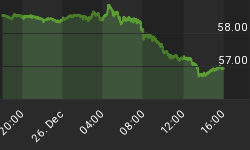The Econoday parrot is squawking about tight inventory management again today. This follows commerce news that month-over-month wholesale trade inventories fell 0.2%. Let's investigate.
Highlights
The nation's inventories, thanks to tight management, are lean which may be a negative for current GDP growth but is unquestionably a positive for future growth and, more importantly, future employment growth. Wholesale inventories slipped 0.2 percent in August vs a preliminary decline of 0.1 percent and compared with a final decline in July which is also at 0.1 percent. August's draw comes at the same time that sales at the wholesale rose very sharply, up 0.7 percent to pull down the stock-to-sales ratio to 1.33 from 1.34.
Inventory to Sales Ratio

My startling conclusion is that parrots cannot read charts.
2016 Inventory Crisis

For a more reasonable synopsis of what is happening with inventories, please consider the Supply Chain article The 2016 Inventory Crisis Continues.
Warehouse vacancy rates in many major cities sit below 5% and a glut of inventory is building up in across retailers in the US.
While volatile consumer demand in itself doesn't explain the glut of inventory, a closer look into consumer behavior does. Thanks to companies like Amazon, today's consumers have incredibly high standards when it comes to product availability, choice, and fulfillment. Out-of-stock inventory, in particular, is a killer of customer loyalty. Shoppers will easily switch to a different retailer, or even a different brand, if what they want is unavailable. Along the same lines, even if a product is available, if a store can't deliver it quickly, painlessly, and likely for free, customers will stray.
The 2016 inventory crisis reflects a struggle. Retailers are grappling with the new innovations brought on by technology companies and the resultant changes to consumer expectations. And maybe taking some action is better than taking no action at all, but the consequences of taking the wrong action for a long period of time can be incredibly high as the current inventory glut and warehouse rates show.
These days, flexibility is best guaranteed through supply chain network technology. Nordstrom recently acquired a minority stake in DS Co., a cloud-based supply chain software firm. The motivation behind the purchase was to make direct shipments from vendors to customers much easier. Direct shipments are a clever way of reducing inventory burdens.
Retailers like Nordstrom wouldn't need to carry inventory themselves, in expensive warehouses and distribution centers. Instead, when customers buy something from a retailer, they receive the goods directly from the vendor. The key to pulling this off is speed and accuracy. Delivery time, from the moment of purchase, has to be short in order to make up for the lack of instant gratification. And the details of the delivery – the right address, timing, packaging, return process – also have to be favorable to the consumer.
As 2016's inventory crisis continues, it'll be interesting to see how many retailers press on with higher rents and larger stocks, versus those who find clever ways to fulfill customer expectations while minimizing costs.
Econoday Parrot
- Inventory is tight
- Inventory positive for future growth
- More importantly, inventory positive for future employment growth
Supply Chain
- Warehouse vacancy rates in many major cities sit below 5%
- A glut of inventory is building up in across retailers in the US
- Retailers turning to direct shipments as a clever way of reducing inventory burdens
Do you believe economic forecasts by Parrots? I don't.
Moreover, as retailers go to direct shipping, there is need for a huge amount of inventory adjustment on top of what any economic slowdown may require.
















